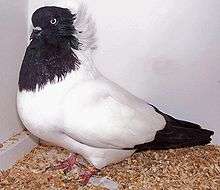Nun pigeon
The Nun is a breed of fancy pigeon developed over many years of selective breeding, was also known as the Dutch Shell Pigeon in continental Europe. Nuns, along with other varieties of domesticated pigeons, are all descendants from the rock pigeon (Columba livia).[1] The Nun is one of the oldest breeds and was originally a flying tumbler before being developed for exhibition.[2] It is a mostly white breed, with a hood of feathers which gives the name to the breed.
 Nun | |
| Conservation status | Common |
|---|---|
| Other names | Dutch Shell Pigeon |
| Classification | |
| US Breed Group | Fancy |
| EE Breed Group | Tumbler Pigeons |
| |
Description
.jpg)
The Nun is given its name by the raised feathers which form a kind of hood which covers the back of the neck and head.[3] Continental Europe previously referred to the Nun as the Dutch Shell Pigeon during the early part of the 20th century.[4] It resembles the tumbler,[5] from which this breed of pigeon originated;[2] although as with all domestic pigeons they are descended from the rock pigeon (Columba livia).[6] They have mostly white bodies and are designated according to the color of their head, i.e. a black headed Nun, or a yellow headed Nun.[7] Only the head, tail and the flight feathers should be so colored.[8] Nuns are one breed in a group of pigeons who fly at high altitudes, along with types of tumblers and the magpie pigeon.[9]
The British Nun Club standard for the Nun states that the ideal size for male birds should be 9 inches (23 cm) from the top of the bird's head to their feet, and 10 inches (25 cm) from the front of the chest to its tail. Female and young birds should be roughly the same size. The beak should be straight but stout, and the eyes a pearly white.[10]
Charles Darwin referred to the Nun in The Variation of Animals and Plants Under Domestication, where he described how the Nun and Jacobin breeds of pigeon have evolved to have less caudal vertebrae than the rock pigeon, from which they originate.[6]
See also
- German Nun
- List of pigeon breeds
References
- Levi, Wendell (1977). The Pigeon. Sumter, S.C.: Levi Publishing Co, Inc. ISBN 0-85390-013-2.
- Seymour, Rev. Colin, ed. (2006). Australian Fancy Pigeons National Book of Standards.
- Figuier, Louis; Gillmore, Parker (1873). Reptiles and Birds. New York: Cassell, Petter, & Galpin. p. 452.
- Townend Barton, Frank (1911). The Boy Fancier. London: George Routledge & Sons. p. 306.
- Beeton, Isabella Mary, ed. (1863). The Book of Household Management. London: S. O. Beeton. pp. 212.
- Darwin, Charles (1896). The Variation of Animals and Plants Under Domestication Part One. New York: D. Appleton and Co. p. 175.
- "The Journal of Horticulture Cottage Gardener, and Country Gentleman". VI (New Series). 1864: 425. Cite journal requires
|journal=(help) - Ames, D. F. (1838). Cottage Comforts. New York: D. F. Ames. p. 325.
- Vriends, Matthew; Erskine, Tommy; Earle-Bridges, Michele (2004). Pigeons. Barron's Educational Series: Hauppauge, NY. p. 87. ISBN 978-0-7641-2991-9.
- "BNC Standard of perfection for Nuns". British Nun Club. Retrieved 28 May 2011.
External links
| Wikimedia Commons has media related to Nun (pigeon). |